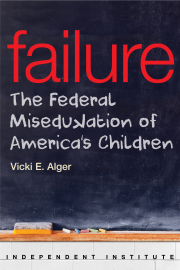In late June Congress froze the interest rate on federally subsidized student loans at 3.4 percent for another year. Senate Finance Committee Chairman Max Baucus claimed the extension would “make a high-quality education affordable for millions of students across the country.”
President Obama was more dramatic. “If Congress does not get this done,” he warned as Congress considered the rate freeze, “the average student with federal student loans will rack up an additional $1,000 in debt over the coming year. More than 7 million students will suddenly be hit with the equivalent of a $1,000 tax hike.”
White House press secretary Jay Carney equated the extension with “offering hardworking students a fair shot at an affordable education.”
In reality, extending the 3.4 percent interest rate for an additional year will save students with federal loans approximately $7 to $10 per month: enough for a couple of burgers with fries. But it will cost taxpayers $6 billion and do virtually nothing to make college more affordable.
That’s because federal aid has not made college more affordable. There is ample evidence, in fact, that federal “aid” has helped drive up college costs and extending the lower interest rate just kicks the can down the road.
The College Cost Reduction and Access Act of 2007 implemented a five-year, incremental reduction in federal student loan rates, with interest rates ranging from 6.8 percent during the 2007-08 academic year to 6.0 percent in 2008-09, 5.6 percent in 2009-10, 4.5 percent in 2010-11, and 3.4 percent in 2011-12.
If Congress had failed to freeze the rate at 3.4 percent, none of the existing loans would have been affected. Instead, it would have meant only that future loans—those taken out after July 1 of this year—would have closed at 6.8 percent, the rate that existed in 2007.
Some 6 million to 7 million out of approximately 19.7 million college students would have been affected.
College tuition has been increasing at about twice the general inflation rate for decades. The American Institute for Economic Research has calculated the increase from 2000 to 2011 at 112 percent.
Much of the increase in college costs has been due to administrative bloat, overbuilding, the proliferation of special-interest centers on campus, and light faculty teaching loads.
One recent analysis by Jay Greene, a professor of education reform at the University of Arkansas, found that the number of college and university administrators had increased more than twice as much as the number of instructors over a 15-year period. This is significant since dozens of mid-level and senior-level administrative positions command six-figure salaries, compared to the relative handful of faculty positions in that range.
Meanwhile, the percentage of students at public universities receiving their degrees within six years of enrolling as freshmen has remained just below 55 percent for a decade. The percentage graduating in four years has been stuck around 30 percent.
Federal subsidies have encouraged this situation. The reason is simple: Colleges are eligible to receive federal funds regardless of their productivity.
College students—and the taxpayers who often help support them—deserve real change, not spare change.
Rather than tinkering with loan interest rates, policymakers should focus on key basics.
Legislators should demand that taxpayer-subsidized institutions provide accurate information, including details about their graduates’ success in the job market. We study everything else; why not this? Then students could make better-informed decisions about the costs of their degrees and their future job prospects.
Policymakers also should require postsecondary institutions to earn their subsidies by implementing “outcomes-based” reforms that provide federal assistance based on course and degree completion rates, instead of enrollment.
And they should encourage alternatives to the traditional four-year college, such as online courses. This would foster meaningful competition for students and introduce powerful pressure on existing institutions to be more efficient.
Such innovative reforms would do far more than a one-time, one-year interest rate freeze to make—and keep—college affordable.








